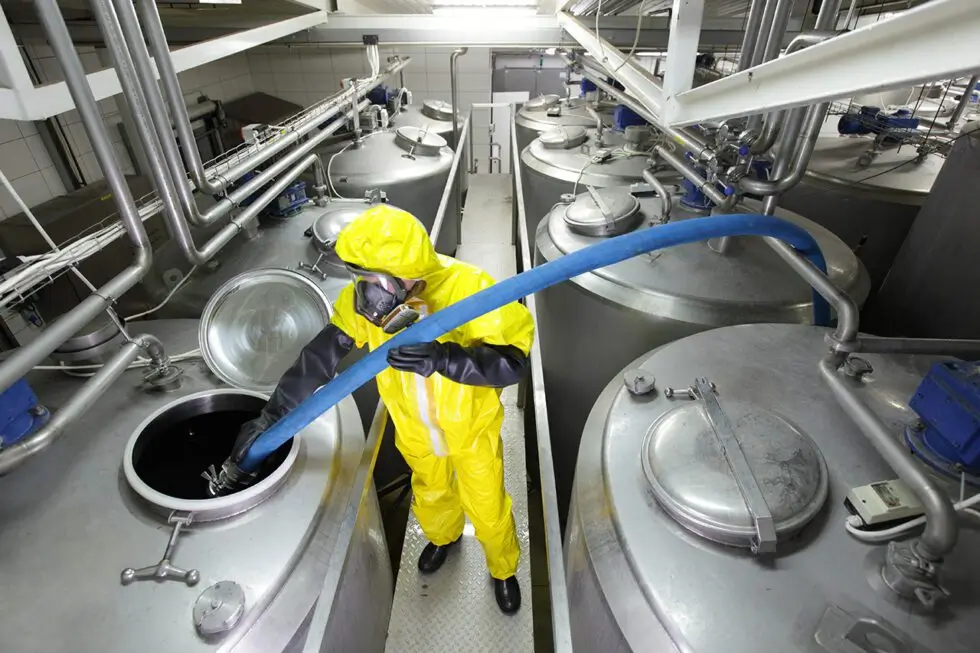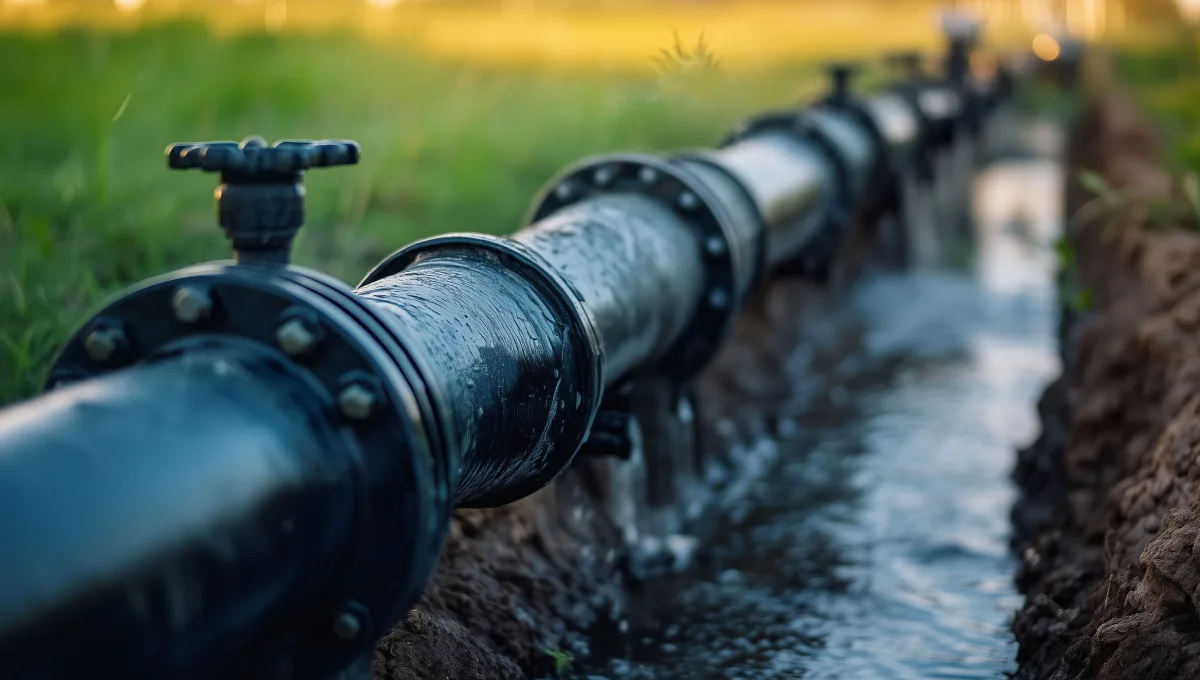Chemical Processing
Chemical processing facilities require reliable transfer systems that withstand corrosion, abrasion, and aggressive chemistries. Anaconda delivers purpose-built chemical processing hose and pipe systems designed for continuous industrial use. Our chemical-resistant HDPE pipe, abrasion-resistant slurry hose, and lay flat hose support the safe movement of chemicals, slurries, and waste streams while reducing maintenance and unplanned downtime. Each solution is engineered for compatibility with corrosive media, elevated temperatures, and demanding flow conditions common in modern processing plants.

Home
Lay Flat Hose
Chemical ProcessingEngineered Pipe and Hose Systems for Chemical Processing
Anaconda provides industrial hose for chemical processing and corrosion-resistant pipe systems tailored for fluid transfer, slurry movement, and discharge operations. Our solutions are built to handle extreme pH levels, suspended solids, high operating pressures, and continuous duty cycles. Plant engineers rely on our systems for dependable uptime, predictable maintenance scheduling, and operational safety across production, blending, and waste treatment lines.


HDPE Pipe for Chemical Processing Applications
for chemical transfer, feed lines, effluent routing, and secondary containment pipelines. HDPE offers excellent compatibility with a wide range of chemicals, making it a strong alternative to metal pipe in corrosive environments.
Key Advantages
- Corrosion-resistant industrial pipe suitable for acids, alkali,s and many solvents
- Pipe material compatible with a wide range of chemicals in processing operations
- Smooth internal bore that reduces scaling and flow losses
- Lightweight for easy handling and faster installation
- Compatible with Bauer-style quick couplings for modular deployment
- Custom chemical process piping solutions available across multiple diameters and pressure ratings

HDPE is frequently selected in chemical plants for process water, chemical dosing lines, reaction-byproduct transfer, and neutralization system routing.

Slurry Hose for High Solids and Corrosive Chemical Streams
Anaconda’s slurry hose line is engineered for high-abrasion environments and high-pressure flow. These hoses support the movement of chemical slurries, catalyst media, abrasive byproducts, and neutralization sludges where both abrasion and chemical exposure are present.
Key Advantages
- Slurry discharge hose for chemical processing with reinforced construction.
- Abrasion-resistant hose for corrosive chemicals that withstands particle impact.
- High-pressure hose for chemical slurries used with pumps and pressurized systems.
- Smooth bore options that reduce clogging and maintain steady flow.
- Available with ANSI 150 flanged ends or custom connections.
- Designed for safe operating temperatures in chemical plants

These hoses perform reliably in environments where high-impact solids, corrosive liquids, and constant flexing intensify wear on traditional hose assemblies.

Lay flat Hose for Flexible Chemical and Slurry Transfer
Our lay flat hose range supports temporary, mobile, and emergency fluid routing within chemical facilities. Designed for flexibility, compact storage, and fast deployment, these hoses are ideal for bypass, washdown, overflow control, and auxiliary pumping operations.
Key Advantages
- Chemical-resistant discharge hose for aggressive environments.
- Lightweight and easy to transport for rapid field deployment.
- Smooth bore layouts that help maintain efficient flow.
- Long continuous lengths reduce connection points and leak potential.
- Suitable for chemical slurry transfer hoses in processing plants.
- Built with materials that handle abrasion, cleaning chemicals, and outdoor exposure.
These hoses perform reliably in environments where high-impact solids, corrosive liquids, and constant flexing intensify wear on traditional hose assemblies.


Built for Abrasion, Corrosion, and High Temperatures in Chemical Plants
All Anaconda products are designed to meet the demanding requirements of chemical processing environments. Our industrial pipe and hose solutions for chemical processing facilities are engineered to withstand corrosive fluids, high temperatures, abrasive particulates, and fluctuating operating pressures. This results in longer service life, reduced maintenance frequency, and safer working conditions across the plant.
Chemical Processing Pipe and Hose Solutions
Product Comparison
Criteria | HDPE Pipe | Slurry Hose | Lay flat Hose |
|---|---|---|---|
Primary Use in Chemical Plants | Permanent or semi-permanent chemical transfer and distribution lines | High abrasion and high-pressure chemical slurry movement | Temporary or mobile chemical and slurry transfer lines |
Chemical Resistance | Excellent resistance to acids, alkalis, and many solvents | Good chemical resistance, depending on the liner compound | Moderate to strong resistance based on material selection |
Abrasion Resistance | Moderate abrasion handling | Very high abrasion handling for solids-loaded fluids | Moderate abrasion handling |
Pressure Capability | Suitable for medium to high pressure, depending on DR rating | Suitable for high-pressure slurry pumping | Suitable for medium pressure and temporary operations |
Temperature Performance | Stable performance in typical chemical processing temperature ranges | Works in medium to high temperature slurry applications | Suitable for field temperature variations and outdoor exposure |
Installation & Handling | Lightweight with long service life and lower installation labor costs | Heavier and requires mechanical handling for larger sizes | Very lightweight and simple to deploy and retrieve |
Flexibility & Routing | Moderate flexibility suitable for above-ground or semi-buried runs | Flexible with high bend tolerance for equipment links | Highly flexible for routing in irregular spaces and temporary paths |
Service Life Expectations | Long lifecycle with low corrosion-related maintenance | Long lifecycle when handling abrasive slurries | Lifecycle depends on deployment cycles and chemical exposure |
Typical Applications | Chemical feed lines, effluent, reaction byproduct transfer, neutralization loops | Catalyst slurry transport, abrasive waste discharge, solids, and sludge movement | Bypass lines, emergency transfer, washdown, mobile or seasonal flow routing |
Connectivity Options | Compatible with quick coupling systems for large diameter pipes | Supplied with ANSI flanged end connections | Works with quick couplings, manifolds, and field connections |
Best Fit Scenario | Permanent chemical process piping solution | Heavy-duty slurry transfer in abrasive environments | Rapid deployment or temporary operational hose needs |
Need help selecting the right pipe or hose for your manufacturing system? Speak with our technical team for a custom product recommendation.
Case study
Improving Chemical Fluid Handling Efficiency and Maintenance Reliability With Anaconda Industrial Pipe and Hose Systems

Client Profile
A mid-size specialty chemical manufacturing facility producing catalysts and industrial treatment compounds. The plant operated multiple fluid and slurry transfer lines between blending, filtration, waste treatment, and holding tank areas.

Challenge
- Corrosion and leakage in metallic coolant lines.
- Frequent hose failures in slurry handling systems.
- Rigid pipeline layouts limit operational flexibility.
- Rising maintenance costs and unplanned production halts.


Solution
The facility was experiencing recurring issues with its existing steel and rubber transfer lines:
- Visible corrosion on metal piping due to aggressive chemical exposure
- Frequent hose replacement caused by abrasive slurry wear
- Extended downtime during maintenance shutdowns
- Slow deployment of temporary bypass lines
- Increasing annual spend on replacement and labor
The engineering team aimed to reduce lifecycle cost, reinforce safety and streamline hose and pipe change-outs without impacting continuous production schedules.

Solution Designed
Following site evaluation and media compatibility review, the facility adopted a three-product approach tailored to different sections of the process line:
1. HDPE Pipe was selected for permanent chemical transfer segments due to corrosion resistance and reduced maintenance requirements.
2. Slurry Hose was chosen for catalyst-laden abrasive discharge pathways, where internal liner durability was critical.
3. Lay flat Hose was introduced as a rapid-deployment option for temporary bypass, tank-to-tank transfers, and maintenance rerouting.


Implementation Steps
- Existing corroded steel pipelines were replaced with HDPE sections in key lines connecting mixing and neutralization units.
- Flanged slurry hoses were installed near slurry pumps and solid-rich discharge locations.
- Lay flat hose sections were configured, stored, and labeled for emergency and scheduled shutdown use.
- Maintenance staff received short training on safe handling and inspection procedures.

Results Achieved
Within the first year of use, the facility reported the following benefits:
- Reduced corrosion-related failures in permanent chemical transfer lines
- Longer service cycle for slurry handling sections exposed to abrasive media
- Faster installation and bypass deployment during scheduled maintenance
- Improved operational safety due to lower handling weight and easier line replacement
- Lower maintenance labor allocation and fewer unplanned production interruptions

Frequently Asked Questions
What is the primary difference between HDPE pipe, slurry hose, and lay flat hose in chemical processing applications?
HDPE pipe is generally used for permanent or long-term fixed pipelines where corrosion resistance, durability, and low maintenance are required. Slurry hose is engineered for media that contains abrasive solids or catalysts, helping reduce wear and premature failure. Lay flat hose is a flexible, portable solution intended for temporary routing, bypass operations, emergency handling, or locations where rapid deployment and storage efficiency are important.
How do I determine whether HDPE pipe is suitable for my specific chemical or fluid?
Chemical suitability depends on the fluid’s composition, concentration, temperature, and operating cycle. HDPE material is compatible with a wide range of corrosive liquids, but final validation should be based on a chemical compatibility chart, environmental exposure, and system duty cycle. Sharing technical parameters with the supplier or engineering team ensures proper material selection.
In what scenarios should a slurry hose be chosen over other hose types?
A slurry hose is most appropriate when the fluid contains high concentrations of suspended solids, abrasive materials, or thick slurry blends that cause erosion in standard hose or pipe systems. Typical areas include discharge from agitators, mixers, centrifuges, filters, or pump outlets where abrasive scouring forces are present.
What makes lay flat hose a valuable option in chemical processing environments?
Lay flat hose is valued for ease of handling, compact storage, and quick field deployment, making it suitable for shutdowns, cleaning cycles, tank transfer, temporary bypass lines, or seasonal operations. It eliminates the need for rigid piping infrastructure when mobility, flexibility, and fast installation are required.
How do pressure ratings impact hose or pipe selection for chemical plants?
Pressure ratings must exceed the maximum operating pressure of the system, including pump surge, head pressure, and any dynamic operational forces. An underrated hose or pipe can deform, fatigue, or fail, while over-specifying can add unnecessary cost. Engineers typically reference both working pressure and recommended safety factors before specifying.
Are the available products suitable for elevated temperature environments?
Temperature affects chemical compatibility, pressure performance, material elasticity, and service life. While these solutions are commonly used in industrial environments, the exact temperature range must align with the product’s published specifications and compatibility guidance. Consulting datasheets during design reduces risk.
What types of connection and coupling options are available for these transfer systems?
Connection types may vary based on product selection and system requirements. Slurry hoses are generally supplied with flanged ends. HDPE pipe may be joined using mechanical couplings or quick-connect fittings. Lay flat hose can connect using couplings, manifolds, adaptors, or auxiliary hardware. Proper end connections improve safety and maintenance access.
How does abrasion exposure influence product selection?
Fluids containing fine or coarse solids create friction and wear along the pipe or hose interior. Slurry hose is built with reinforced elastomeric construction for enhanced abrasion resistance. HDPE pipe offers moderate abrasion performance based on fluid velocity and particulate size. Lay flat hose can handle certain abrasive applications but may be more suitable for intermittent flow conditions.
What installation factors should be considered for each transfer option?
Installation considerations vary between products. HDPE pipe typically requires planned alignment and mechanical support. Slurry hose may require anchoring or alignment with pump discharge lines. Lay flat hose installations focus on surface routing, flexibility, and minimizing twist or kink points. Proper installation extends product service life and ensures safe operation.
Can these transfer solutions be used outside the plant or in remote field environments?
Yes, they can be used outdoors if they match the environmental conditions, such as UV exposure, weathering, operational movement, and handling frequency. Lay flat hose is particularly beneficial for mobile or remote pumping operations where ground adaptation and low-footprint storage are priorities.
Can I customize the length, connection type, and diameter based on my process design?
Most industrial hose and pipe systems can be supplied in multiple diameters and custom lengths to match flow requirements and pressure ratings. Support for custom fittings, flanged ends, and transition adaptors allows integration with existing plant infrastructure without redesigning upstream or downstream equipment.
What information is required from the engineering or maintenance team before product selection?
To provide accurate recommendations, teams should share details such as chemical type and concentration, operating temperature, pressure, expected flow rate, solids content, duty cycle, installation environment, line length, and connection standards. This ensures correct product matching and reduces the risk of over-engineering or premature failure.


 (619) 201-8311
(619) 201-8311